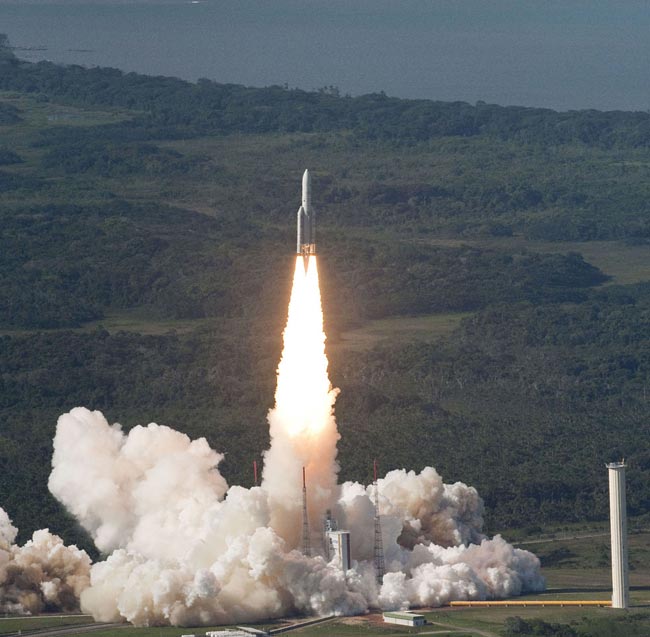New High-Tech Satellites Launched Into Orbit

AnAriane 5 rocket blasted off from French Guiana and soared into a deepblue skyFriday, hauling into space a video broadcasting satellite for Intelsatand ahigh-tech British-owned spacecraft to meet the ever-changing demands ofthevibrant European broadband market.
Therocket took off from the Guiana Space Center at 1839 GMT (1:39 p.m.EST),disappearing into a cloudless sky a few minutes later on the power oftwomassive solid-fueled boosters and an efficient hydrogen-burning Vulcainmainengine. [Photoof the Ariane 5 rocket launch]
Nineminutes after liftoff, the Ariane 5's cryogenic upper stage began anearly16-minute burn to inject the Intelsat 17 and HYLAS 1 payloads into anelliptical orbit that will take the satellites more than 22,000 milesfromEarth.
Accordingto Arianespace, the firm managing the rocket's operations, the missionreached an on-target orbit, completing the Ariane 5's fifthsuccessful flight this year.
Intelsat17 separated from the rocket first, then on-board computers jettisonedadual-payload adapter specially designed for the Ariane'stwo-at-a-time satellitelaunches.HYLAS 1 was released nearly 35 minutes afterliftoff.
Bothsatellites were intentionally left short of their planned operationalpoints inspace, and each craft will fire on-board engines to reach a circular22,300-mile-high orbit over the equator in the coming weeks.
Intelsat17 is bound for a position in geosynchronous orbit over the IndianOcean, aprime location to distribute video and other communications services tocustomers in Europe, Africa, the Middle East and Asia.
Get the Space.com Newsletter
Breaking space news, the latest updates on rocket launches, skywatching events and more!
The12,214-pound spacecraft C-band and Ku-band transponders will operatefor morethan 15 years. It was built by Space Systems/Loral of Palo Alto, Calif.
Intelsatsays the satellite will providea range oftelecommunications services, joining the Intelsat 10spacecraft at an adjacentlocation in geosynchronous orbit. The platform will replace Intelsat702, anaging satellite launched in 1994.
Jean-LucFroeliger, Intelsat's senior director for space systems acquisition,saidground controllers already established contact with the newly-launchedsatellite.
Fourmain engine burns are planned to raise Intelsat 17's orbit togeosynchronousaltitude, and the spacecraft will be handed over from Loral to IntelsatinJanuary to replace older satellites and establish fresh capacity.
"Ithas a very diversified customer base that includes media customers,governmentservices and corporate networks," Froeliger said in post-launch remarksfrom Kourou.
HYLAS1 is the product of a unique public-private partnership between theEuropeanSpace Agency, the U.K. Space Agency, the Indian Space ResearchOrganization andEADS Astrium.
Thepartnership's beneficiary is Avanti Communications of the UnitedKingdom, anentrepreneurial firm with a mission to link rural European residentsthroughbroadband Internet services.
HYLASstands for Highly Adaptable Satellite, denoting the craft's ability toallocateon-board resources to meet spikes and lulls in demand.
"It'sEurope's first broadband satellite and it will begin to bridge thedigitaldivide, which is a source currently of inequality in our society," saidDavid Williams, CEO of Avanti.
Thenew capability, funded by ESA and engineered by Astrium, will giveAvanti"the ability to independently adjust our uplink frequency, our downlinkfrequency, our bandwidth and our power," said J. Cooke, the HYLAS 1satellite mission director from Avanti Communications.
ESAinitially provided $45 million to jump start the development of HYLAS1'sgeneric flexible payload. The funding came through ESA's AdvancedResearch inTelecommunications, or ARTES, program. The agency has two morepublic-private projectsin the pipeline for launch in the next few years, includingpartnerships withHispasat for a small communications satellite and Inmarsat for Europe'snext-generation Alphasat platform.
"ESAis providing a brand new technology and Avanti is using that brand newtechnology to deliver services to Europe," said Jean-Jacques Dordain,ESA's director general.
Theinstitutional budget from ESA and the British government convincedprivateinvestors to contribute more than $500 million to Avanti, according toWilliams.
"Spaceis an industry with great barriers to entry, so it's some surprise thatAvantimanaged to get here," Williams said.
Avantiofficials say HYLAS 1's Ka-band and Ku-band payload will serve between150,000and 300,000 users in Europe from a position at 33.5 degrees westlongitude. The5,666-pound satellite was built by Antrix, a subsidiary of the Indianspaceagency, and should last more than 15 years.
HYLAS1 was originally contracted to fly on a SpaceXFalcon 9 rocket, but Avanti switched toArianespace in 2009 to allayinvestors' concerns about launch risks. Arianespace assigned HYLAS 1 tolaunchon the first Soyuz rocket flight from French Guiana, but launch paddevelopmentdelays forced another rocket change to the workhorse Ariane 5 to ensureliftoffby the end of 2010.
"Avantihas tonight grown up a little and joined the European space family, andthat'sa family which I'm very proud to be a part of," Williams said.
Arianespaceplans to end the year with asixth Ariane 5 launch Dec.21 to deliver to space the Hispasat 1E and Koreasat 6 satellites forSpanishand Korean operators.
- Photos:DazzlingMidnight Launch ofShuttle Discovery
- Video:AmazingRocket Launch: 'Thisis so cool!'
- SecretU.S. SpySatellite LaunchesInto Orbit on Huge Rocket
Copyright 2010 SpaceflightNow.com,all rights reserved.

Join our Space Forums to keep talking space on the latest missions, night sky and more! And if you have a news tip, correction or comment, let us know at: community@space.com.
Stephen Clark is the Editor of Spaceflight Now, a web-based publication dedicated to covering rocket launches, human spaceflight and exploration. He joined the Spaceflight Now team in 2009 and previously wrote as a senior reporter with the Daily Texan. You can follow Stephen's latest project at SpaceflightNow.com and on Twitter.









